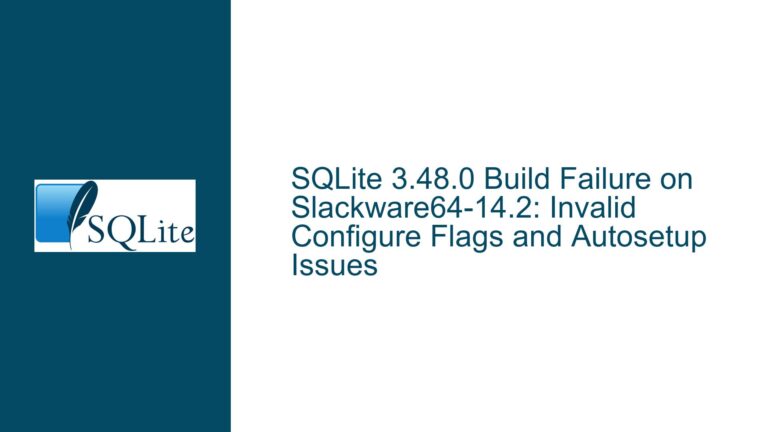Potential Array Indexing Issue in SQLite’s exprAnalyze Function
Understanding the Array Allocation Idiom in SQLite’s ExprList Structure
The core issue revolves around the interpretation of the ExprList structure in SQLite, specifically the a[1] array declaration. This structure is defined as follows:
struct ExprList {
int nExpr; /* Number of expressions on the list */
int nAlloc; /* Number of a[] slots allocated */
struct ExprList_item { /* For each expression in the list */
...
} a[1]; /* One slot for each expression in the list */
};
At first glance, the a[1] declaration suggests that the array a can only hold one element. However, this is a common C-language idiom used to facilitate dynamic array sizing. When memory is allocated for the ExprList structure, additional space is reserved beyond the base structure to accommodate more elements in the a array. The actual number of elements in the array is determined by nAlloc, which indicates the total number of allocated slots, and nExpr, which indicates how many of those slots are currently in use.
This idiom allows SQLite to manage arrays of varying sizes efficiently without resorting to more complex data structures like linked lists. It is a memory-efficient technique that leverages the flexibility of C’s memory management system. However, it can be confusing for static analysis tools like Veracode, which may not recognize this pattern and could flag it as a potential out-of-bounds access issue.
Potential Misinterpretation by Static Analysis Tools
Static analysis tools, such as Veracode, are designed to identify potential vulnerabilities and coding errors by analyzing source code without executing it. These tools often rely on predefined patterns and heuristics to detect issues. In the case of the ExprList structure, the tool might misinterpret the a[1] declaration as a fixed-size array with only one element. Consequently, when the code iterates over the array using a loop counter that exceeds the declared size (e.g., i < 2), the tool could flag this as a potential out-of-bounds access.
This misinterpretation arises because static analysis tools may not account for the dynamic memory allocation pattern used in the ExprList structure. The tool assumes that the array size is fixed at one element, leading to a false positive when the code attempts to access elements beyond the first index. This highlights a limitation of static analysis tools in understanding certain C-language idioms, particularly those involving dynamic memory allocation and flexible array members.
Resolving the False Positive in Static Analysis
To address the false positive flagged by Veracode, it is essential to understand the underlying memory allocation pattern used in the ExprList structure. The a[1] declaration is not indicative of the actual array size but rather a placeholder for the start of the array. The actual size of the array is determined by the nAlloc field, which specifies the total number of allocated slots.
When memory is allocated for the ExprList structure, the size calculation includes additional space for the a array beyond the single element declared in the structure. This allows the array to hold nAlloc elements, even though the structure definition only declares one element. The nExpr field then tracks how many of these allocated slots are currently in use.
To resolve the false positive, it is necessary to provide context to the static analysis tool about the dynamic nature of the a array. This can be achieved through code annotations or tool-specific configuration settings that inform the tool about the actual array size. For example, some static analysis tools support annotations that specify the relationship between the nAlloc field and the size of the a array. By adding such annotations, the tool can correctly interpret the array bounds and avoid flagging legitimate code as problematic.
Additionally, it may be helpful to document the memory allocation pattern in the code to ensure that future developers and analysis tools understand the intended behavior. Clear comments and documentation can prevent similar misunderstandings and reduce the likelihood of false positives in static analysis.
Best Practices for Handling Dynamic Arrays in C
The ExprList structure in SQLite exemplifies a common pattern for handling dynamic arrays in C. This pattern involves declaring a one-element array at the end of a structure and then allocating additional memory to accommodate more elements. While this approach is efficient and widely used, it requires careful management to avoid errors and ensure compatibility with static analysis tools.
One best practice is to use the flexible array member feature introduced in C99. This feature allows the last member of a structure to be an array of unspecified size, providing a more explicit and standardized way to implement dynamic arrays. For example, the ExprList structure could be rewritten as follows:
struct ExprList {
int nExpr; /* Number of expressions on the list */
int nAlloc; /* Number of a[] slots allocated */
struct ExprList_item { /* For each expression in the list */
...
} a[]; /* Flexible array member */
};
Using a flexible array member makes the dynamic nature of the array more apparent and can help static analysis tools better understand the intended behavior. However, this approach requires C99 or later, which may not be feasible in all environments.
Another best practice is to ensure that all memory allocations and accesses are properly bounds-checked. This includes verifying that the nAlloc field accurately reflects the allocated size of the array and that the nExpr field does not exceed nAlloc. By implementing robust bounds checking, developers can prevent out-of-bounds access errors and improve the reliability of their code.
Finally, it is important to communicate the intended behavior of dynamic arrays to static analysis tools through annotations, configuration settings, or documentation. This can help reduce false positives and ensure that the tools provide accurate and actionable feedback.
Conclusion
The issue with the ExprList structure in SQLite highlights the challenges of using static analysis tools to validate code that employs advanced C-language idioms. While these tools are valuable for identifying potential vulnerabilities, they may not always understand the nuances of dynamic memory allocation and flexible array members. By understanding the underlying patterns and best practices, developers can effectively address false positives and ensure that their code is both robust and compatible with static analysis tools.
In summary, the a[1] declaration in the ExprList structure is a common C idiom for implementing dynamic arrays. Static analysis tools like Veracode may misinterpret this pattern, leading to false positives. To resolve this issue, developers should provide context to the tools, use best practices for dynamic arrays, and ensure proper bounds checking. By doing so, they can maintain the integrity and reliability of their code while leveraging the benefits of static analysis.






